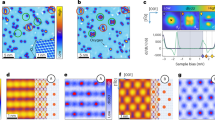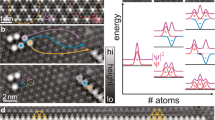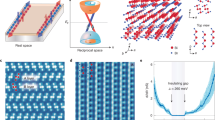Abstract
Ordered assemblies of magnetic atoms on the surface of conventional superconductors can be used to engineer topological superconducting phases and realize Majorana fermion quasiparticles (MQPs) in a condensed matter setting. Recent experiments have shown that chains of Fe atoms on Pb generically have the required electronic characteristics to form a one-dimensional topological superconductor and have revealed spatially resolved signatures of localized MQPs at the ends of such chains. Here we report higher-resolution measurements of the same atomic chain system performed using a dilution refrigerator scanning tunnelling microscope (STM). With significantly better energy resolution than previous studies, we show that the zero-bias peak (ZBP) in Fe chains has no detectable splitting from hybridization with other states. The measurements also reveal that the ZBP exhibits a distinctive ‘double eye’ spatial pattern on nanometre length scales. Theoretically we show that this is a general consequence of STM measurements of MQPs with substantial spectral weight in the superconducting substrate, a conclusion further supported by measurements of Pb overlayers deposited on top of the Fe chains. Finally, we report experiments performed with superconducting tips in search of the particle–hole symmetric MQP signature expected in such measurements.
This is a preview of subscription content, access via your institution
Access options
Subscribe to this journal
Receive 12 print issues and online access
$209.00 per year
only $17.42 per issue
Buy this article
- Purchase on Springer Link
- Instant access to full article PDF
Prices may be subject to local taxes which are calculated during checkout






Similar content being viewed by others
References
Kitaev, A. Y. Unpaired Majorana fermions in quantum wires. Phys.-Usp. 44, 131–136 (2001).
Alicea, J. New directions in the pursuit of Majorana fermions in solid state systems. Rep. Progr. Phys. 75, 076501 (2012).
Beenakker, C. W. J. Search for Majorana fermions in superconductors. Ann. Rev. Condens. Matter Phys. 4, 113–136 (2013).
Majorana, E. Teoria simmetrica dell’elettrone e del positrone. Il Nuovo Cimento 14, 171–184 (1937).
Kitaev, A. Y. Fault-tolerant quantum computation by anyons. Ann. Phys. 303, 2–30 (2003).
Nayak, C., Simon, S. H., Stern, A., Freedman, M. & Das Sarma, S. Non-Abelian anyons and topological quantum computation. Rev. Mod. Phys. 80, 1083–1159 (2008).
Salomaa, M. M. & Volovik, G. E. Cosmiclike domain walls in superfluid 3He-B: instantons and diabolical points in (k, r) space. Phys. Rev. B 37, 9298–9311 (1988).
Ivanov, D. A. Non-abelian statistics of half-quantum vortices in p-wave superconductors. Phys. Rev. Lett. 86, 268–271 (2001).
Moore, G. & Read, N. Nonabelions in the fractional quantum Hall-effect. Nuclear Phys. B 360, 362–396 (1991).
Read, N. & Green, D. Paired states of fermions in two dimensions with breaking of parity and time-reversal symmetries and the fractional quantum Hall effect. Phys. Rev. B 61, 10267–10297 (2000).
Fu, L. & Kane, C. L. Superconducting proximity effect and Majorana fermions at the surface of a topological insulator. Phys. Rev. Lett. 100, 096407 (2008).
Lutchyn, R. M., Sau, J. D. & Das Sarma, S. Majorana fermions and a topological phase transition in semiconductor–superconductor heterostructures. Phys. Rev. Lett. 105, 077001 (2010).
Oreg, Y., Refael, G. & von Oppen, F. Helical liquids and Majorana bound states in quantum wires. Phys. Rev. Lett. 105, 177002 (2010).
Choy, T. P., Edge, J. M., Akhmerov, A. R. & Beenakker, C. W. J. Majorana fermions emerging from magnetic nanoparticles on a superconductor without spin–orbit coupling. Phys. Rev. B 84, 195442 (2011).
Kjaergaard, M., Wölms, K. & Flensberg, K. Majorana fermions in superconducting nanowires without spin–orbit coupling. Phys. Rev. B 85, 020503 (2012).
Nadj-Perge, S., Drozdov, I. K., Bernevig, B. A. & Yazdani, A. Proposal for realizing Majorana fermions in chains of magnetic atoms on a superconductor. Phys. Rev. B 88, 020407 (2013).
Pientka, F., Glazman, L. I. & von Oppen, F. Topological superconducting phase in helical Shiba chains. Phys. Rev. B 88, 155420 (2013).
Klinovaja, J., Stano, P., Yazdani, A. & Loss, D. Topological superconductivity and Majorana fermions in RKKY systems. Phys. Rev. Lett. 111, 186805 (2013).
Braunecker, B. & Simon, P. Interplay between classical magnetic moments and superconductivity in quantum one-dimensional conductors: toward a self-sustained topological Majorana phase. Phys. Rev. Lett. 111, 147202 (2013).
Vazifeh, M. M. & Franz, M. Self-organized topological state with Majorana fermions. Phys. Rev. Lett. 111, 206802 (2013).
Nakosai, S., Tanaka, Y. & Nagaosa, N. Two-dimensional p-wave superconducting states with magnetic moments on a conventional s-wave superconductor. Phys. Rev. B 88, 180503 (2013).
Rontynen, J. & Ojanen, T. Topological superconductivity and high Chern numbers in 2D ferromagnetic Shiba lattices. Phys. Rev. Lett. 114, 236803 (2015).
Nadj-Perge, S. et al. Observation of Majorana fermions in ferromagnetic atomic chains on a superconductor. Science 346, 602–607 (2014).
Li, J. et al. Topological superconductivity induced by ferromagnetic metal chains. Phys. Rev. B 90, 235433 (2014).
Mourik, V. et al. Signatures of Majorana fermions in hybrid superconductor–semiconductor nanowire devices. Science 336, 1003–1007 (2012).
Sun, H.-H. et al. Majorana zero mode detected with spin selective Andreev reflection in the vortex of a topological superconductor. Phys. Rev. Lett. 116, 257003 (2016).
Das, A. et al. Zero-bias peaks and splitting in an Al–InAs nanowire topological superconductor as a signature of Majorana fermions. Nat. Phys. 8, 887–895 (2012).
Deng, M. T. et al. Anomalous zero-bias conductance peak in a Nb–InSb nanowire–Nb hybrid device. Nano Lett. 12, 6414–6419 (2012).
Finck, A. D. K., Van Harlingen, D. J., Mohseni, P. K., Jung, K. & Li, X. Anomalous modulation of a zero-bias peak in a hybrid nanowire-superconductor device. Phys. Rev. Lett. 110, 126406 (2013).
Rokhinson, L. P., Liu, X. & Furdyna, J. K. The fractional a.c. Josephson effect in a semiconductor–superconductor nanowire as a signature of Majorana particles. Nat. Phys. 8, 795–799 (2012).
Albrecht, S. M. et al. Exponential protection of zero modes in Majorana islands. Nature 531, 206–209 (2016).
Liu, J., Potter, A. C., Law, K. T. & Lee, P. A. Zero-Bias peaks in the tunneling conductance of spin-orbit-coupled superconducting wires with and without Majorana end-states. Phys. Rev. Lett. 109, 267002 (2012).
Lee, E. J. H. et al. Zero-bias anomaly in a nanowire quantum dot coupled to superconductors. Phys. Rev. Lett. 109, 186802 (2012).
Churchill, H. O. H. et al. Superconductor-nanowire devices from tunneling to the multichannel regime: zero-bias oscillations and magnetoconductance crossover. Phys. Rev. B 87, 241401 (2013).
Pikulin, D. I., Dahlhaus, J. P., Wimmer, M., Schomerus, H. & Beenakker, C. W. J. A zero-voltage conductance peak from weak antilocalization in a Majorana nanowire. New J. Phys. 14, 125011 (2012).
Kells, G., Meidan, D. & Brouwer, P. W. Near-zero-energy end states in topologically trivial spin–orbit coupled superconducting nanowires with a smooth confinement. Phys. Rev. B 86, 100503 (2012).
Zhang, H. et al. Ballistic Majorana nanowire devices. Preprint at http://arXiv.org/abs/1603.04069 (2016).
Pawlak, R. et al. Probing atomic structure and Majorana wavefunctions in mono-atomic Fe-chains on superconducting Pb-surface. Preprint at http://arXiv.org/abs/1505.06078 (2015).
Ruby, M. et al. End states and subgap structure in proximity-coupled chains of magnetic adatoms. Phys. Rev. Lett. 115, 197204 (2015).
Dumitrescu, E., Roberts, B., Tewari, S., Sau, J. D. & DasSarma, S. Majorana fermions in chiral topological ferromagnetic nanowires. Phys. Rev. B 91, 094505 (2015).
Peng, Y., Pientka, F., Glazman, L. I. & von Oppen, F. Strong localization of Majorana end states in chains of magnetic adatoms. Phys. Rev. Lett. 114, 106801 (2015).
Yu, L. Bound state in superconductors with paramagnetic impurities. Acta Phys. Sin. 21, 75–91 (1965).
Shiba, H. Classical spins in superconductors. Progr. Theor. Phys. 40, 435–451 (1968).
Rusinov, A. I. On theory of gapless superconductivity in alloys containing paramagnetic impurities. Sov. Phys. Jetp-Ussr 29, 1101–1106 (1969).
Peng, Y., Pientka, F., Vinkler-Aviv, Y., Glazman, L. I. & von Oppen, F. Robust Majorana conductance peaks for a superconducting lead. Phys. Rev. Lett. 115, 266804 (2015).
Misra, S. et al. Design and performance of an ultra-high vacuum scanning tunneling microscope operating at dilution refrigerator temperatures and high magnetic fields. Rev. Sci. Instrum. 84, 103903 (2013).
Ruby, M., Heinrich, B. W., Pascual, J. I. & Franke, K. J. Experimental demonstration of a two-band superconducting state for lead using scanning tunneling spectroscopy. Phys. Rev. Lett. 114, 157001 (2015).
Law, K. T., Lee, P. A. & Ng, T. K. Majorana fermion induced resonant Andreev reflection. Phys. Rev. Lett. 103, 237001 (2009).
Sau, J. D. & Brydon, P. M. R. Bound states of a ferromagnetic wire in a superconductor. Phys. Rev. Lett. 115, 127003 (2015).
Meng, T., Klinovaja, J., Hoffman, S., Simon, P. & Loss, D. Superconducting gap renormalization around two magnetic impurities: from Shiba to Andreev bound states. Phys. Rev. B 92, 064503 (2015).
Krogstrup, P. et al. Epitaxy of semiconductor–superconductor nanowires. Nat. Mater. 14, 400–406 (2015).
Li, J., Neupert, T., Bernevig, B. A. & Yazdani, A. Manipulating Majorana zero modes on atomic rings with an external magnetic field. Nat. Commun. 7, 10395 (2016).
Acknowledgements
The work at Princeton has been supported by ONR-N00014-14-1-0330, ONR-N00014-11-1-0635, ONR-N00014-13-10661, NSF-MRSEC programs through the Princeton Center for Complex Materials DMR-142054, NSF-DMR-1104612, NSF-DMR-1420541, NSF EAGER Award NOA-AWD1004957, DOE DE-SC0016239, Simons Investigator Award, Packard Foundation and Schmidt Fund for Innovative Research, and by the Gordon and Betty Moore Foundation as part of EPiQS initiative (GBMF4530). This project was also made possible using the facilities at Princeton Nanoscale Microscopy Laboratory supported by grants through ARO-MURI Program W911NF-12-1-0461, DOE-BES, LPS and ARO-W911NF-1-0606, and Eric and Wendy Schmidt Transformative Technology Fund at Princeton. B.E.F. acknowledges financial support from the Dicke Fellowship. M.T.R. acknowledges support from the NSF Graduate Research Fellowship Program.
Author information
Authors and Affiliations
Contributions
B.E.F., M.T.R. and I.K.D. performed the dilution refrigerator STM measurements. S.J., Y.X. and I.K.D. conducted the measurements on Fe chains capped with Pb overlayers. J.L., Z.W. and B.A.B. performed the theoretical modelling and simulations. All authors contributed to analysing the data and writing the manuscript.
Corresponding author
Ethics declarations
Competing interests
The authors declare no competing financial interests.
Supplementary information
Supplementary information
Supplementary information (PDF 1467 kb)
Rights and permissions
About this article
Cite this article
Feldman, B., Randeria, M., Li, J. et al. High-resolution studies of the Majorana atomic chain platform. Nature Phys 13, 286–291 (2017). https://doi.org/10.1038/nphys3947
Received:
Accepted:
Published:
Issue Date:
DOI: https://doi.org/10.1038/nphys3947
This article is cited by
-
Antiferromagnetism-driven two-dimensional topological nodal-point superconductivity
Nature Communications (2023)
-
Probing the topologically trivial nature of end states in antiferromagnetic atomic chains on superconductors
Nature Communications (2023)
-
Determining the temperature of a millikelvin scanning tunnelling microscope junction
Communications Physics (2023)
-
Single-electron charge transfer into putative Majorana and trivial modes in individual vortices
Nature Communications (2023)
-
Recent progress on non-Abelian anyons: from Majorana zero modes to topological Dirac fermionic modes
Science China Physics, Mechanics & Astronomy (2023)



